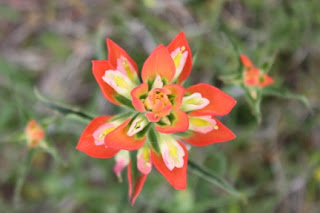Pied Beauty
Gerard Manley Hopkins (1844-1889)
Glory be to God for dappled things—
For skies of couple-colour as a brinded cow;
For rose-moles all in stipple upon trout that swim;
Fresh-firecoal chestnut-falls; finches' wings;
Landscape plotted and pieced—fold, fallow, and plough;
And all trades, their gear and tackle and trim.
All things counter, original, spare, strange;
Whatever is fickle, freckled (who knows how?)
With swift, slow; sweet, sour; adazzle, dim;
He fathers-forth whose beauty is past change:
Praise him.
Glory be to God for dappled things—
For skies of couple-colour as a brinded cow;
For rose-moles all in stipple upon trout that swim;
Fresh-firecoal chestnut-falls; finches' wings;
Landscape plotted and pieced—fold, fallow, and plough;
And all trades, their gear and tackle and trim.
All things counter, original, spare, strange;
Whatever is fickle, freckled (who knows how?)
With swift, slow; sweet, sour; adazzle, dim;
He fathers-forth whose beauty is past change:
Praise him.
Wednesday, March 30, 2011
Monday, March 28, 2011
Eggs With Leftovers
Recently a friend gave me a dozen fresh eggs, courtesy of her backyard hens. After sharing them with my coworker, I took home six and improvised a great dinner of fresh eggs with leftovers. It's based on a recipe I saw years ago, now lost. I wish I could remember more about that original recipe -- kudos to the long-forgotten cook -- but suffice it to say that my version had its origins in a cooking magazine.
This recipe serves 2 hungry adults and 1 finicky kid, or 2 hungry adults only, which is about the same amount.
6 eggs
2-3 tablespoons milk
salt and pepper
half an onion, thinly sliced
half a red bell pepper, thinly sliced
a quantity of cooking oil
about a quarter-pound each of cooked ham and cooked chicken
cooked French fries, enough to mix in the eggs and serve on the side (try sweet potato fries!)
Beat the eggs lightly with the milk, salt and pepper in a medium bowl and set aside. Warm the oil in the skillet over medium heat and sauté the onions or about 8 minutes, or until lightly browned. Add the red bell peppers and cook until softened, about 5 more minutes. Mix in the chicken and ham and stir until heated through.
Now mix in the eggs and cook until almost set. Then mix in some of the French fries, reserving most of them for serving alongside the eggs. Serve with your choice of toppings -- we like fresh salsa!
Try this recipe anytime a generous friend gives you yard eggs! You can substitute freely, using whatever leftovers you have -- this is just what we had on hand.
This recipe serves 2 hungry adults and 1 finicky kid, or 2 hungry adults only, which is about the same amount.
6 eggs
2-3 tablespoons milk
salt and pepper
half an onion, thinly sliced
half a red bell pepper, thinly sliced
a quantity of cooking oil
about a quarter-pound each of cooked ham and cooked chicken
cooked French fries, enough to mix in the eggs and serve on the side (try sweet potato fries!)
 |
| The ingredients |
 |
| In the skillet |
 |
| Ready to eat! |
Monday, March 21, 2011
Once Were Wildflowers
The annual Texas wildflower fever is just beginning around here -- everybody loves wildflowers in March. It's kind of surprising that they do, to tell the truth. After all, most wildflowers have a rather weedy appearance close up. Our very favorite one, the Texas Bluebonnet, has a very short bloom cycle. As a group, they're fairly unreliable: sometimes we have a banner year, and sometimes, depending on the rain, we get nothing at all.
What interests me is how we got from wildflowers to garden flowers. I enjoy reading about the dedicated plant breeders who carry on improving our species plants until we can barely recognize them. Even more interesting? Reading about how genetic researchers use plant DNA to track human migrations, based on the plants (and pollens and seeds) they carried with them.
I like to think about those people who long ago were entranced by the subtle beauty of a native wildflower. What it must have been like to live in a world where all flowers were wildflowers! It seems incredible that we ended up here, in a world in which woodland plants bloom in the full sun, scentless roses flower 12 months long, and our wildflowers have morphed into bedding color. And a little sad, really, that we only appreciate seasonality, subtlety and brevity in March. After that? We move on to evergreen, everblooming, dwarfing sameness.
What interests me is how we got from wildflowers to garden flowers. I enjoy reading about the dedicated plant breeders who carry on improving our species plants until we can barely recognize them. Even more interesting? Reading about how genetic researchers use plant DNA to track human migrations, based on the plants (and pollens and seeds) they carried with them.
I like to think about those people who long ago were entranced by the subtle beauty of a native wildflower. What it must have been like to live in a world where all flowers were wildflowers! It seems incredible that we ended up here, in a world in which woodland plants bloom in the full sun, scentless roses flower 12 months long, and our wildflowers have morphed into bedding color. And a little sad, really, that we only appreciate seasonality, subtlety and brevity in March. After that? We move on to evergreen, everblooming, dwarfing sameness.
Wednesday, March 16, 2011
Thursday, March 10, 2011
Lovely Luna Moth
Once you get over the shock, it's quite a pleasure to watch a Luna Moth unfurl from its cocoon. Even here in the wilds of the Texas Gulf Coast, a huge green moth is unusual. The Luna, even more so, because it usually flies at night, in search of a mate. It takes a few hours for the moth to take its final form. When it first emerges from the cocoon, its wings are small, nothing at all like the 4" wingspan it eventually attains.
The adult Luna lives less than a week, and does not even eat, lacking a mouth. It lives only to mate, and then passes on to its reward. This moth hatched from a cocoon very near a sweetgum tree, a host plant for Luna larvae. I'll keep my eye out for the next generation!
 |
| Almost done! |
The adult Luna lives less than a week, and does not even eat, lacking a mouth. It lives only to mate, and then passes on to its reward. This moth hatched from a cocoon very near a sweetgum tree, a host plant for Luna larvae. I'll keep my eye out for the next generation!
 |
| Long hindwings not yet unfolded... |
 |
| Unfolded, but needs to dry a bit more |
Thursday, March 3, 2011
The Plant That Assigns Chores
I have a lovely little cherry bush that wants me to paint the garage. The first few years I had it, it was a shy, unassuming little thing. Made no demands. Grew slowly but steadily. Bloomed sporadically the first spring but very nicely thereafter.
The bossy behavior started last year, when the cherry was at its peak. "Paint the garage!" it insisted. The argument was that the beautiful light pink blossoms were lost against the dull beige of the garage siding. The cherry advocated for a dark forest green, but that annoyed the spider lily, whose strap-like foliage is that very same color. I viewed slate gray as a compromise color, but nothing was accomplished last year.
This year, the cherry is adamant. Either I paint the garage to show off the pink spring finery or else! Or else what, I do not know. I hate to think what a vengeful shrub can do -- I've witnessed the wrath of Climbing Old Blush, so I'm a believer!
The cherry is "Hirome," or "Hiromi," a Prunus jacquemontii dwarf flowering cherry that is extremely well suited to the hot, humid south. I have mine planted on the east side of the offensive garage, where it gets morning sun. I don't do anything at all to it -- no pruning, fertilizing, spraying, and very little additional water now that it's established. It's about 5 feet tall, and a great favorite of the mockingbirds when the fruits (gumball-sized) come in.
 |
| Hirome, a dwarf flowering cherry |
The bossy behavior started last year, when the cherry was at its peak. "Paint the garage!" it insisted. The argument was that the beautiful light pink blossoms were lost against the dull beige of the garage siding. The cherry advocated for a dark forest green, but that annoyed the spider lily, whose strap-like foliage is that very same color. I viewed slate gray as a compromise color, but nothing was accomplished last year.
 |
| The complainant, stomping its feet on the leucojum. |
This year, the cherry is adamant. Either I paint the garage to show off the pink spring finery or else! Or else what, I do not know. I hate to think what a vengeful shrub can do -- I've witnessed the wrath of Climbing Old Blush, so I'm a believer!
The cherry is "Hirome," or "Hiromi," a Prunus jacquemontii dwarf flowering cherry that is extremely well suited to the hot, humid south. I have mine planted on the east side of the offensive garage, where it gets morning sun. I don't do anything at all to it -- no pruning, fertilizing, spraying, and very little additional water now that it's established. It's about 5 feet tall, and a great favorite of the mockingbirds when the fruits (gumball-sized) come in.
Subscribe to:
Posts (Atom)







.jpg)




